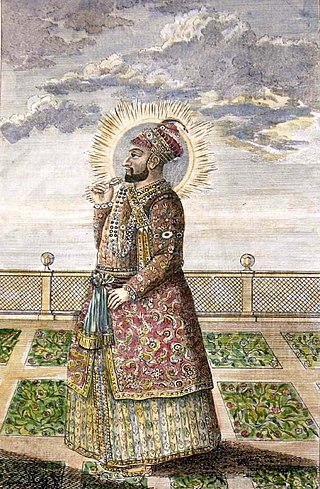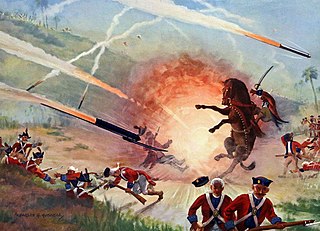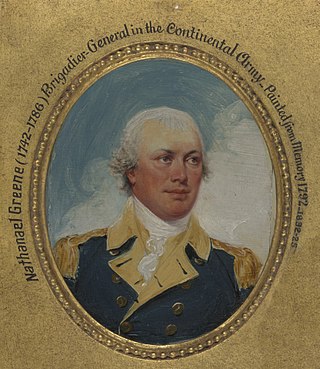
Hyder Ali was the Sultan and de facto ruler of the Kingdom of Mysore in southern India. Born as Hyder Ali, he distinguished himself as a soldier, eventually drawing the attention of Mysore's rulers. Rising to the post of Dalavayi (commander-in-chief) to Krishnaraja Wodeyar II, he came to dominate the titular monarch and the Mysore government. He became the de facto ruler, King of Mysore as Sarvadhikari by 1761. During intermittent conflicts against the East India Company during the First and Second Anglo–Mysore Wars, Hyder Ali was the military leader.

Lieutenant-General Sir Eyre Coote, KB was an Anglo-Irish military officer and politician who sat in the House of Commons from 1768 to 1780. He is best known for his many years of service with the British Army in India. His victory at the Battle of Wandiwash is considered a decisive turning point in the struggle for control in India between Britain and France. He was known by his sepoy troops as Coote Bahadur.

General Sir Hector Munro, 8th Laird of Novar, KB was a British Army officer and politician who sat in the British House of Commons representing the constituency of Inverness Burghs from 1768 to 1802.

The Battle of Pollilur, also known as the Battle of Polilore or Battle of Perambakam, took place on 10 September 1780 at Pollilur near Conjeevaram, the city of Kanchipuram in present-day Tamil Nadu state, India, as part of the Second Anglo-Mysore War. It was fought between an army commanded by King Tipu Sultan of the Kingdom of Mysore, and a British East India Company force led by William Baillie. The EIC force suffered a high number of casualties before surrendering. It was the worst loss the East India Company suffered on the subcontinent until Chillianwala. Benoît de Boigne, a French officer in the service of 6th Regiment of Madras Native Infantry, wrote, "There is not in India an example of a similar defeat".

The Second Anglo-Mysore War was a conflict between the Kingdom of Mysore and the British East India Company from 1780 to 1784. At the time, Mysore was a key French ally in India, and the conflict between Britain against the French and Dutch in the American Revolutionary War influenced Anglo-Mysorean hostilities in India. The great majority of soldiers on the company side were raised, trained, paid and commanded by the company, not the British government. However, the company's operations were also bolstered by Crown troops sent from Great Britain, and by troops from Hanover, which was also ruled by Great Britain's King George III.

The First Anglo-Mysore War (1767–1769) was a conflict in India between the Sultanate of Mysore and the East India Company. The war was instigated in part by the machinations of Asaf Jah II, the Nizam of Hyderabad, who sought to divert the company's resources from attempts to gain control over the Northern Circars.

The Anglo-Mysore Wars were a series of four wars fought during the last three decades of the 18th century between the Sultanate of Mysore on the one hand, and the British East India Company, Maratha Empire, Kingdom of Travancore, and the Kingdom of Hyderabad on the other. Hyder Ali and his succeeding son Tipu fought the wars on four fronts: with the British attacking from the west, south and east and the Nizam's forces attacking from the north. The fourth war resulted in the overthrow of the house of Hyder Ali and Tipu, and the dismantlement of Mysore to the benefit of the East India Company, which took control of much of the Indian subcontinent.

The Battle of Hobkirk's Hill was a battle of the American Revolutionary War fought on April 25, 1781, near Camden, South Carolina. A small American force under Nathanael Greene occupying Hobkirk's Hill, north of Camden, was attacked by British troops led by Francis Rawdon. After a fierce clash, Greene retreated, leaving Rawdon's smaller force in possession of the hill.

Eyre Coote was an Irish-born British soldier and politician who served as Governor of Jamaica. He attained the rank of general in the British Army and was created a Knight Grand Cross of the Order of the Bath before being stripped of his rank and honours in 1816 after conduct unbecoming an officer and a gentleman.
The 89th Regiment of Foot was a regiment of the British Army, raised on 3 December 1793. Under the Childers Reforms the regiment amalgamated with the 87th Regiment of Foot to form the Princess Victoria's in 1881.

Major-General James Stuart was a British Army officer who served in various conflicts in India during the 18th century. His service in the East India Company was marked by his conflict with Lord Pigot, the governor of Madras; Stuart's arrest of the latter in 1776 resulted in his suspension as commander-in-chief, and he was not vindicated until 1780. He later fought in the Second Anglo-Mysore War, but was suspended from command in 1782 by Lord Macartney, an action that provoked a duel between the two men. Stuart was a younger brother of the lawyer and politician Andrew Stuart.

The Madras Army was the army of the Presidency of Madras, one of the three presidencies of British India within the British Empire. The Madras Army was originally intended to be composed only of Rajputs, Mussalmans, and the three Telugu castes the Kammas, the Razus and the Velamas.

The Battle of Koregaon was fought on 1 January 1818 between the British East India Company and the Peshwa faction of the Maratha Confederacy, at Koregaon Bhima.

The siege of Negapatam was the first major offensive military action on the Indian subcontinent following the arrival of news that war had been declared between Great Britain and the Dutch Republic, beginning the Fourth Anglo-Dutch War. A British force besieged the Dutch-controlled port of Negapatam, the capital of Dutch Coromandel, on the eastern coast of India, which capitulated after the fortification's walls were breached. The Dutch garrison consisted of 500 European troops, 5,500 local troops, and 2,000 troops of Hyder Ali, the ruler of Mysore.

The Battle of Porto Novo was fought on 1 July 1781 between forces of the Kingdom of Mysore and British East India Company in the place called Porto Novo on the Indian subcontinent, during the Second Anglo-Mysore War. The British force, numbering more than 8,000 men under the command of Sir Eyre Coote defeated a force estimated at 40,000 under the command of Hyder Ali.

The Battle of Sholinghur was fought on 27 September 1781 at Sholinghur, 80 kilometres (50 mi) West of Chennai (Madras), between forces of the Kingdom of Mysore led by Hyder Ali and East India Company forces led by General Eyre Coote. Haider Ali's forces were surprised by the company forces and they were expelled from the Carnatic with heavy casualties.

The Mysorean invasion of Malabar (1766–1792) was the military invasion of the Malabar region of Kerala, including the territories of the Zamorin of Calicut, by the then-de facto ruler of the Kingdom of Mysore, Hyder Ali. After the invasion, the Kingdom of Cochin to the south of Malabar became a tributary state of Mysore.
The Battle of Tiruvannamalai is one of the two successful battles fought by the Madras Army in the Carnatic along with the Battle of Chengam. It was fought on 25 September 1767 between the allied forces led by the East India Company against the troops of Hyder Ali. The allied forces of the English army were led by Colonel Smith.
Colonel Thomas Dean Pearse was a British Army officer who served as a colonel in the Bengal Army's artillery. He took an interest in astronomy and conducted many surveys during his service in India.





















